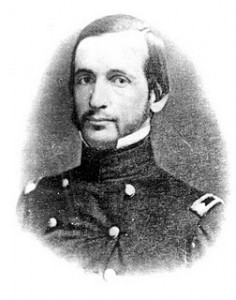The Origin of California’s Great Seal
The state seal was approved during the constitutional convention convened September 4, 1849, one year prior to California’s 1850 admission as the 31st state.
Major Robert S. Garnett, a native of Virginia, was the designer. Twenty-seventh in his class at West Point and sent to California to deliver dispatches, Garnett became the academy’s commandant in 1852.
He submitted his sketch for the seal through Caleb Lyon, one of the participants in the constitutional convention.
Garnett used Lyon as a go-between, afraid his idea would be rejected because of his being a member of the Army and a supporter of Thomas Butler King, a Georgia politician who was President Zachary Taylor’s “special agent” in California and had designs on being one of the new state’s first US senators.
Garnett’s seal depicted San Francisco Bay, dotted with sailings ships, and gold miners in the background behind Minerva, the Roman goddess of wisdom whose sprang full grown from the head of Jupiter, just as California was emerging as a full grown state.
There was a grizzly bear and 31 stars around the edge representing California as the 31ststate and a motto, “Eureka.”
According to Mary Jo Ignoffo’s well-researched Gold Rush Politics:
“Some delegates (to the convention) requested slight modifications. Mariano Vallejo requested the grizzly be lassoed, symbolizing the conquest of California. His request was overruled and the grizzly remained untethered.
“The convention approved the design and directed Lyon to have it cast. Later, a wood carving of the Great Seal was also created and it hung in the various statehouses at subsequent capitols.
(The constitutional convention was held at Colton Hall in San Jose.)
“In 1854, the wooden seal was rescued form a fire by Lyon and from there it languished in a family bank vault until 1932.”
The seal then came to a Pasadena museum, which exhibited it until 1955 when it was sold as part of a larger collection to the Bill Harrah who displayed it in his Reno museum.
In 1981, the seal came home to California.
Garnett eventually resigned his commission in the US Army and became a brigadier general in the Confederate Army, commanding the South’s forces in Viriginia.
Felled by Union gunfire near Corricks Ford in 1861, Garnett was the first general — of either side — killed in the Civil War.
-30-
Filed under: California History
Capitol Cliches Conversational Currency Great Moments in Capitol History News Budget and Economy California History Demographics Fundraising Governor Legislature/Legislation Politics State Agencies
Opinionation Overheard Today's Latin Lesson
Restaurant Raconteur Spotlight Trip to Tokyo Venting Warren Buffett Welcome Words That Aren't Heard in Committee Enough


Very interesting. Corricks Ford is in West Virginia and is two hours west of where I now live near Leesburg, VA
Comment by Michael Jarvis — 12.29.2011 @ 9:39 am